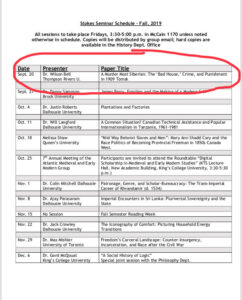It is a little strange being on sabbatical during this pandemic and the accompanying social distancing. The TRU community is figuring out how to work its shift to on-line instruction. Nova Scotia (where I’m located) has declared a state of emergency, and we’re supposed to go out only for neighbourhood walks (avoiding people) and essentials. Not everyone is following the rules. So far the number of cases in NS is relatively small. Given my job and situation, I’m certainly one of the lucky ones right now.
Quite grateful for my tenured job and my sabbatical. If the worst work-related news is that I'm having trouble concentrating, I'm in a very, very fortunate situation. My heart goes out to everyone! Stay healthy.
— Wilson Bell (@bellhistory) March 23, 2020
Of course, my worst work-related news (still not that bad, considering) is almost certainly that my 2.5-month, 3-country trip to Europe, starting in May, will be cancelled. For the month of May, I am officially a Visiting Scholar in Paris at L’École des hautes études en sciences sociales (EHESS) and some of my talks have even been advertised. EHESS has cancelled the visiting scholar program for April, but has not yet made a decision for May. Even if it goes ahead (however unlikely that is), TRU has banned foreign travel through April and seems likely to extend that ban. And how wise would it be to go, anyway?
After Paris, I was planning on two weeks of research in England (at the British Library and at Oxford University), followed by one month of research in Russia.
While I’m sad that this trip almost certainly won’t happen, this problem is nothing compared to what many people are going through. I can conduct some of my research through on-line sources (such as the Tomsk NKVD Remand Prison Museum website) and via materials that I’ve already collected and other on-line resources.
With kids at home, and worries about the state of the world, it is certainly difficult concentrating on research and writing. If anyone has tips, those would be greatly appreciated. Mostly though, it seems like a good time to be concentrating on kindness and empathy. Please take care, and thanks for reading!



 at Dalhousie. I took German and Holocaust history courses with him, and was especially fond of the tangential stories he would tell related to certain historical figures and events.
at Dalhousie. I took German and Holocaust history courses with him, and was especially fond of the tangential stories he would tell related to certain historical figures and events. it is also my first publication dealing with contemporary Russia.
it is also my first publication dealing with contemporary Russia. ve a large discount: the paperback version is only $19.95 at the moment! UTP has been a pleasure to work with, so far. I already have one speaking engagement lined up to discuss my book: a talk at Wilfred Laurier University’s Centre for Military, Strategic and Disarmament Studies on Jan. 9, 2019. Details to follow, but you can also
ve a large discount: the paperback version is only $19.95 at the moment! UTP has been a pleasure to work with, so far. I already have one speaking engagement lined up to discuss my book: a talk at Wilfred Laurier University’s Centre for Military, Strategic and Disarmament Studies on Jan. 9, 2019. Details to follow, but you can also 